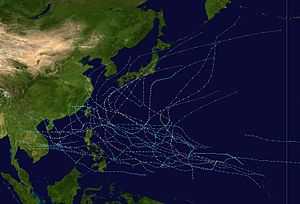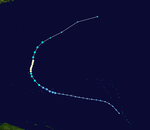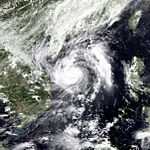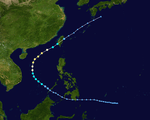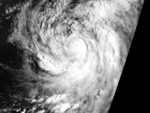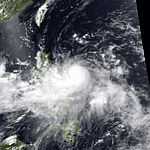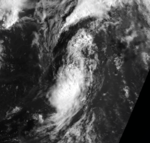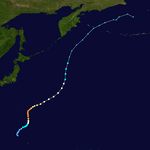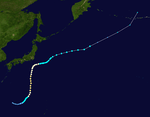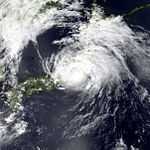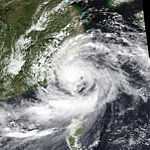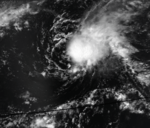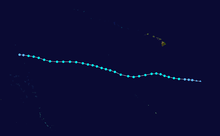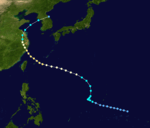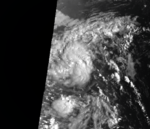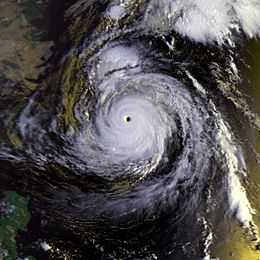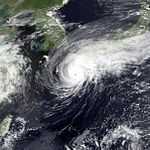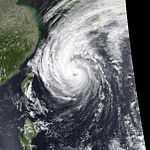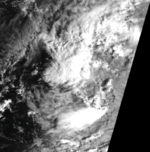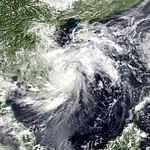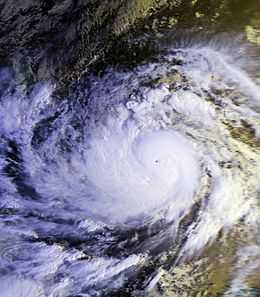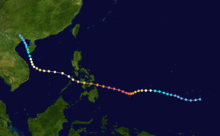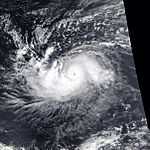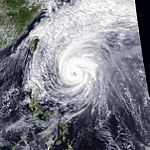1990 Pacific typhoon season
| |
| Season summary map |
| First system formed |
January 12, 1990 |
| Last system dissipated |
December 23, 1990 |
| Strongest storm |
Flo – 890 hPa (mbar), 220 km/h (140 mph) (10-minute sustained) |
| Total depressions |
35 |
| Total storms |
32 |
| Typhoons |
18 |
| Super typhoons |
4 |
| Total fatalities |
>1,576 |
| Total damage |
$2.7 billion (1990 USD) |
Pacific typhoon seasons
1988, 1989, 1990, 1991, 1992 |
The 1990 Pacific typhoon season has no official bounds; it ran year-round in 1990, but most tropical cyclones tend to form in the northwestern Pacific Ocean between May and November.[1] These dates conventionally delimit the period of each year when most tropical cyclones form in the northwestern Pacific Ocean.
The scope of this article is limited to the Pacific Ocean, north of the equator and west of the international date line. Storms that form east of the date line and north of the equator are called hurricanes; see 1990 Pacific hurricane season. Tropical Storms formed in the entire west Pacific basin were assigned a name by the Joint Typhoon Warning Center. Tropical depressions in this basin have the "W" suffix added to their number. Tropical depressions that enter or form in the Philippine area of responsibility are assigned a name by the Philippine Atmospheric, Geophysical and Astronomical Services Administration or PAGASA. This can often result in the same storm having two names.
Season summary

Storms
35 tropical cyclones formed this year in the Western Pacific, of which 32 became tropical storms. 18 storms reached typhoon intensity, of which 4 reached super typhoon strength.
Severe Tropical Storm Koryn
| Severe tropical storm (JMA) |
| Category 1 typhoon (SSHWS) |
|
|
| Duration |
January 12 – January 17 |
| Peak intensity |
100 km/h (65 mph) (10-min) 980 mbar (hPa) |
On January 12, both the JMA and the JTWC identified a tropical depression in the northwest Pacific Ocean. The depression intensified over the period of a day to become a tropical storm on January 13, when it received the name Koryn from the JTWC. According to them, but not the JMA, Koryn reached hurricane-equivalent strength on January 15, when it peaked in intensity. The storm then weakened quite rapidly until it became extratropical on January 17, at 0000 UTC.
Tropical Storm Lewis
| Tropical storm (JMA) |
| Tropical storm (SSHWS) |
|
|
| Duration |
April 28 – May 4 |
| Peak intensity |
65 km/h (40 mph) (10-min) 998 mbar (hPa) |
Tropical Storm Lewis was a minimal tropical storm that only held said intensity for two days.
Typhoon Marian
| Typhoon (JMA) |
| Category 2 typhoon (SSHWS) |
|
|
| Duration |
May 15 – May 19 |
| Peak intensity |
130 km/h (80 mph) (10-min) 965 mbar (hPa) |
CMA Tropical Depression 04
| Tropical depression (CMA) |
|
|
| Duration |
May 20 – May 23 |
| Peak intensity |
55 km/h (35 mph) (10-min) 1000 mbar (hPa) |
CMA Tropical Depression 05
| Tropical depression (CMA) |
|
|
| Duration |
May 24 – May 28 |
| Peak intensity |
55 km/h (35 mph) (10-min) 1000 mbar (hPa) |
Tropical Depression 04W
| Tropical depression (HKO) |
| Tropical depression (SSHWS) |
|
|
| Duration |
June 14 – June 16 |
| Peak intensity |
55 km/h (35 mph) (10-min) 995 mbar (hPa) |
Severe Tropical Storm Nathan (Akang)
| Severe tropical storm (JMA) |
| Tropical storm (SSHWS) |
|
|
| Duration |
June 13 – June 19 |
| Peak intensity |
100 km/h (65 mph) (10-min) 980 mbar (hPa) |
A tropical disturbance trekked across the Philippines in mid June, upon entering the South China Sea a depression formed. The depression was upgraded to Tropical Storm Nathan on June 16. Tropical Storm Nathan reached peak intensity of 65 mph (100 km/h) shortly before striking Hainan Island. In the South China Sea the Chinese ship Tien Fu sank killing 4 people. In southern China torrential rains caused flooding in Guangdong and Zhanjian Provinces killing 10 people, two people drowned in Macau due to high waves. Tropical Storm Nathan then continued northwestwards making a final landfall near the Vietnam/China border.[2]
Typhoon Ofelia (Bising)
| Typhoon (JMA) |
| Category 2 typhoon (SSHWS) |
|
|
| Duration |
June 16 – June 25 |
| Peak intensity |
120 km/h (75 mph) (10-min) 970 mbar (hPa) |
The monsoon trough spawned a tropical depression east of the Philippines on June 15. It tracked to the northwest then westward, slowly organizing into a tropical storm on June 18. Ofelia turned more to the northwest and became a typhoon on June 20. Paralleling the east coast of the Philippines, it reached a peak of 100 mph (155 km/h) winds before hitting Taiwan on June 23. Ofelia weakened over the country, and brushed eastern China before dissipating on June 25 near Korea. Ofelia caused heavy flooding throughout its track, resulting in at least 64 casualties.
Typhoon Percy (Klaring)
| Typhoon (JMA) |
| Category 4 typhoon (SSHWS) |
|
|
| Duration |
June 20 – June 30 |
| Peak intensity |
150 km/h (90 mph) (10-min) 950 mbar (hPa) |
Typhoon Percy, which developed on June 20, reached a peak of 135 mph winds while located a short distance east of the northern Philippines. Increasing vertical shear weakened Percy to a 95 mph typhoon before crossing extreme northern Luzon on the 27th, an area that felt the effects of Ofelia only days before. It remained a weak typhoon until hitting southeastern China on the 29th before dissipating on the 1st. Percy caused serious damage and flooding in the Carolina Islands and northern Philippines, amounting to 9 deaths.
Tropical Storm Robyn (Deling)
| Tropical storm (JMA) |
| Tropical storm (SSHWS) |
|
|
| Duration |
July 4 – July 13 |
| Peak intensity |
85 km/h (50 mph) (10-min) 992 mbar (hPa) |
CMA Tropical Depression 11
| Tropical depression (CMA) |
|
|
| Duration |
July 20 – July 23 |
| Peak intensity |
55 km/h (35 mph) (10-min) 1000 mbar (hPa) |
Typhoon Steve
| Typhoon (JMA) |
| Category 4 typhoon (SSHWS) |
|
|
| Duration |
July 23 – August 3 |
| Peak intensity |
155 km/h (100 mph) (10-min) 940 mbar (hPa) |
Severe Tropical Storm Tasha (Emang)
| Severe tropical storm (JMA) |
| Tropical storm (SSHWS) |
|
|
| Duration |
July 21 – August 1 |
| Peak intensity |
100 km/h (65 mph) (10-min) 980 mbar (hPa) |
65 mph Tropical Storm Tasha, which developed on July 22 and meandered through the South China Sea, hit southern China on the 30th, 75 miles east of Hong Kong. The storm caused torrential flooding in southern China, causing widespread damage and 108 fatalities.
Typhoon Vernon
| Typhoon (JMA) |
| Category 2 typhoon (SSHWS) |
|
|
| Duration |
July 26 – August 9 |
| Peak intensity |
140 km/h (85 mph) (10-min) 955 mbar (hPa) |
CMA Tropical Depression 14
| Tropical depression (SSHWS) |
|
|
| Duration |
July 26 – July 27 |
| Peak intensity |
55 km/h (35 mph) (1-min) 1000 mbar (hPa) |
Severe Tropical Storm Winona
| Severe tropical storm (JMA) |
| Category 1 typhoon (SSHWS) |
|
|
| Duration |
August 4 – August 11 |
| Peak intensity |
110 km/h (70 mph) (10-min) 975 mbar (hPa) |
The origins of Winona can be traced back to Severe Tropical Storm Tasha.
On August 2, the remnant low of Tasha, as a patch of thunderstorms over northeastern China, was pushed to the east by a weather front from the west. By August 4, Tasha entered the Yellow Sea, before being pushed south by an anticyclone off northeastern Korea, into the East China Sea.
Although the same system, Tasha was named Winona, as it started to strengthen into a tropical storm by August 7. It reached peak intensity with an eye-like feature on August 8, before landfalling over Japan the next day. Later, the remnants became extratropical.
Typhoon Yancy (Gading)
| Typhoon (JMA) |
| Category 2 typhoon (SSHWS) |
|
|
| Duration |
August 11 – August 23 |
| Peak intensity |
150 km/h (90 mph) (10-min) 950 mbar (hPa) |
Typhoon Yancy killed 12 people in the Philippines after a landslide destroyed a dormitory. In China, severe damage occurred and at least 216 people were killed.At least 14 people were killed in Taiwan.[3]
Tropical Storm Aka
| Tropical storm (JMA) |
| Tropical storm (SSHWS) |
|
|
| Duration |
August 13 (Entered basin) – August 15 |
| Peak intensity |
75 km/h (45 mph) (10-min) 994 mbar (hPa) |
Typhoon Zola
| Typhoon (JMA) |
| Category 3 typhoon (SSHWS) |
|
|
| Duration |
August 15 – August 23 |
| Peak intensity |
140 km/h (85 mph) (10-min) 960 mbar (hPa) |
On August 15, an large area of convection associated with the inflow of
developing Typhoon Yancy was cut off, as Yancy was moving too fast to the west for the convection in the east to be absorbed into Yancy. By August 16, the convection developed a mid to low level circulation, and developed into tropical storm by August 18. Zola intensified into a typhoon by the next day, before reaching peak intensity on August 21. By the next day, Zola made landfall over Japan, before dissipating north of Japan.
High winds and heavy rains produced by the storm killed three people and injured 22 others in Japan.
Typhoon Abe (Heling)
| Typhoon (JMA) |
| Category 2 typhoon (SSHWS) |
|
|
| Duration |
August 23 – September 2 |
| Peak intensity |
140 km/h (85 mph) (10-min) 955 mbar (hPa) |
137 casualties can be attributed to Typhoon Abe, a typhoon hitting China and bringing heavy rain to Taiwan and the Philippines. It lasted from August 22 through the 2nd, and peaked at 100 mph winds. The storm killed at least 250 people[4] and caused 3.5 billion yuan[5] (approx. $607 million 1990 USD[6] or over $1 billion 2013 USD[7]) in damages.
Typhoon Becky (Iliang)
| Typhoon (JMA) |
| Category 1 typhoon (SSHWS) |
|
|
| Duration |
August 23 – August 30 |
| Peak intensity |
130 km/h (80 mph) (10-min) 965 mbar (hPa) |
Tropical Storm Becky, having developed on August 20, hit northern Luzon on the 26th as a strong tropical storm. It strengthened over the South China Sea to an 80 mph typhoon, and hit northern Vietnam at that intensity on the 29th. Becky was responsible for killing 32 people and causing heavy flooding.
Tropical Storm Cecil
| Tropical storm (HKO) |
| Tropical storm (SSHWS) |
|
|
| Duration |
September 2 – September 5 |
| Peak intensity |
85 km/h (50 mph) (10-min) 990 mbar (hPa) |
Typhoon Dot (Loleng)
| Typhoon (JMA) |
| Category 1 typhoon (SSHWS) |
|
|
| Duration |
September 3 – September 11 |
| Peak intensity |
140 km/h (85 mph) (10-min) 960 mbar (hPa) |
Typhoon Dot formed from a monsoon trough to the southwest of Guam. Dot moved steadily towards the northwest and strengthened into a typhoon. Typhoon Dot reached peak intensity of 85 mph before weakening slight before landfall on eastern Taiwan on the 7th of September. After passing Taiwan Dot regained typhoon intensity in the Formosa Strait before making a final landfall in Fujian Province, China. On northern Luzon Island rains from Typhoon Dot caused floods killing 4 people, on Taiwan 3 people died.[2]
Typhoon Ed (Miding)
| Typhoon (JMA) |
| Category 2 typhoon (SSHWS) |
|
|
| Duration |
September 9 – September 20 |
| Peak intensity |
130 km/h (80 mph) (10-min) 965 mbar (hPa) |
Severe flooding produced by the storm killed at least 18 people in Vietnam. At least 4,500 homes were destroyed and another 140,000 were inundated.[8]
Super Typhoon Flo
| Typhoon (JMA) |
| Category 5 super typhoon (SSHWS) |
|
|
| Duration |
September 12 – September 20 |
| Peak intensity |
220 km/h (140 mph) (10-min) 890 mbar (hPa) |
Typhoon Flo, which developed on September 12, rapidly intensified on the 16th and 17th to a 165 mph super typhoon near Okinawa. Vertical shear weakened it as it recurved to the northeast, and Flo hit Honshū, Japan on the 19th as a 100 mph typhoon. It continued rapidly northeastward, became extratropical on the 20th, and dissipated on the 22nd. Widespread flooding and landslides killed 32 and caused millions in damage.
Typhoon Gene (Norming)
| Typhoon (JMA) |
| Category 1 typhoon (SSHWS) |
|
|
| Duration |
September 22 – September 30 |
| Peak intensity |
150 km/h (90 mph) (10-min) 950 mbar (hPa) |
A tropical disturbance consolidated into a tropical depression on the 23rd of September to the east of the Philippines. Tropical Storm Gene was named as the storm moved towards the northwest and strengthened into a typhoon the next day. Typhoon Gene reached peak intensity of 95 mph on the 27th shortly before recurving towards the northeast. Gene then skimmed the coasts of Kyūshū, Shikoku and Honshū Islands in Japan before moving out to sea and turning extratropical. Winds on 85 mph were recorded on Kyūshū and heavy rains fell across the region, resulting floods and landslides killed 4 people.[2]
Typhoon Hattie (Oyang)
| Typhoon (JMA) |
| Category 2 typhoon (SSHWS) |
|
|
| Duration |
September 30 – October 8 |
| Peak intensity |
150 km/h (90 mph) (10-min) 950 mbar (hPa) |
Typhoon Hattie formed as Typhoon Gene was accelerating towards Japan. Hattie strengthened into a typhoon on the 3rd of October while moving towards the northwest and reached a peak intensity of 105 mph the next day. Typhoon Hattie began to recurve while west of the island of Okinawa. Heavy rains from Typhoons Flo, Gene and Hattie broke the drought that plagued the island. As Hattie accelerated towards Japan it was downgraded to a tropical storm before brushing pass Kyūshū and Shikoku before making landfall on Honshū Island. Heavy rains caused a landslide on Shikoku Island killing three people when a landslide hit a bus.[2]
Tropical Storm Ira
| Tropical storm (JMA) |
| Tropical storm (SSHWS) |
|
|
| Duration |
October 1 – October 5 |
| Peak intensity |
65 km/h (40 mph) (10-min) 996 mbar (hPa) |
Severe flooding in Thailand triggered by heavy rains from Ira killed at least 24 people.[9]
Tropical Storm Jeana (Pasing)
| Tropical depression (HKO) |
| Tropical storm (SSHWS) |
|
|
| Duration |
October 12 – October 15 |
| Peak intensity |
55 km/h (35 mph) (10-min) 1000 mbar (hPa) |
Typhoon Kyle
| Typhoon (JMA) |
| Category 2 typhoon (SSHWS) |
|
|
| Duration |
October 14 – October 22 |
| Peak intensity |
140 km/h (85 mph) (10-min) 955 mbar (hPa) |
Tropical Storm Lola
| Tropical storm (JMA) |
| Tropical storm (SSHWS) |
|
|
| Duration |
October 16 – October 20 |
| Peak intensity |
65 km/h (40 mph) (10-min) 998 mbar (hPa) |
Extreme rainfall, peaking near 31.5 in (800 mm) triggered extensive flooding that left some regions under 6 ft (1.8 m) of water. At least 16 people were killed by the storm.[10]
Super Typhoon Mike (Ruping)
| Typhoon (JMA) |
| Category 5 super typhoon (SSHWS) |
|
|
| Duration |
November 6 – November 18 |
| Peak intensity |
185 km/h (115 mph) (10-min) 915 mbar (hPa) |
Main article:
Typhoon MikeSuper Typhoon Mike was the deadliest typhoon of the season. It struck the central Philippines in mid-November, where landslides, flooding, and extreme wind damage to caused over 748 casualties and over $1.94 billion in damage (1990 USD).[11] The name Mike was retired after this season and replaced with Manny.
Severe Tropical Storm Nell
| Severe tropical storm (JMA) |
| Tropical storm (SSHWS) |
|
|
| Duration |
November 9 – November 12 |
| Peak intensity |
95 km/h (60 mph) (10-min) 990 mbar (hPa) |
Super Typhoon Owen
| Typhoon (JMA) |
| Category 5 super typhoon (SSHWS) |
|
|
| Duration |
November 20 – December 4 |
| Peak intensity |
175 km/h (110 mph) (10-min) 925 mbar (hPa) |
As Super Typhoon Owen crossed the Marshall Islands and Caroline Islands in mid to late November, it caused extreme damage to the many islands. Some islands lost 95%-99% of the dwellings, as well as 80-90% crops being destroyed. Through all of the damage, Owen only killed 2 people. [12]
Super Typhoon Page (Susang)
| Typhoon (JMA) |
| Category 5 super typhoon (SSHWS) |
|
|
| Duration |
November 21 – December 3 |
| Peak intensity |
195 km/h (120 mph) (10-min) 910 mbar (hPa) |
Super Typhoon Page formed on November 21 as a tropical depression. From there, it tracked slowly westward, making a cyclonic loop. Page continued westward, and strengthened into a Category 5 typhoon. It then accelerated northeastward, making landfall in Japan on November 30 as a Category 1 typhoon. Page dissipated over northeast Japan on December 3.[12]
Typhoon Russ
| Typhoon (JMA) |
| Category 4 typhoon (SSHWS) |
|
|
| Duration |
December 13 – December 23 |
| Peak intensity |
185 km/h (115 mph) (10-min) 915 mbar (hPa) |
The final storm of the season, which formed on December 13, brought heavy damage to Guam when it crossed near the island on December 20. Damage estimates are as high as $120 million (1990 USD), but nobody perished in the storm.
1990 storm names
Western North Pacific tropical cyclones were named by the Joint Typhoon Warning Center. The first storm of 1990 was named Koryn and the final one was named Russ. The name Mike was retired after this season, and was replaced by Manny, as evidenced in the 1993 Pacific typhoon season.
- Koryn (9001)
- Lewis (9002)
- Marian (9003)
- Nathan (9004)
- Ofelia (9005)
- Percy (9006)
|
- Robyn (9007)
- Steve (9008)
- Tasha (9009)
- Vernon (9010)
- Winona (9011)
- Yancy (9012)
|
- Zola (9014)
- Abe (9015)
- Becky (9016)
- Cecil
- Dot (9017)
- Ed (9018)
|
- Flo (9019)
- Gene (9020)
- Hattie (9021)
- Ira (9022)
- Jeana
- Kyle (9023)
|
- Lola (9024)
- Mike (9025)
- Nell (9026)
- Owen (9027)
- Page (9028)
- Russ (9029)
|
One storm which formed in the Central Pacific basin, Tropical Storm Aka (01C), crossed into the Western Pacific basin as a tropical storm, keeping its original name and "C" suffix, with the JMA giving the designation 9013.
Philippines
The Philippine Atmospheric, Geophysical and Astronomical Services Administration (PAGASA) uses its own naming scheme for tropical cyclones within its area of responsibility. Lists are recycled every four years. This is the same list used for the 1986 season. The name Ruping was retired after this year and was replaced by Ritang.
- Akang (9005)
- Bising (9006)
- Klaring (9007)
- Deling (9008)
- Emang (9009)
|
- Gading (9012)
- Heling (9015)
- Iliang (9016)
- Loleng (9017)
- Miding (9018)
|
|
-
Tering (unused)
-
Uding (unused)
-
Weling (unused)
-
Yaning (unused)
-
Aning (unused)
|
-
Bidang (unused)
-
Katring (unused)
-
Delang (unused)
-
Esang (unused)
-
Garding (unused)
|
See also
References
External links
| 1990–1999 Pacific typhoon seasons |
|---|
| |
|
